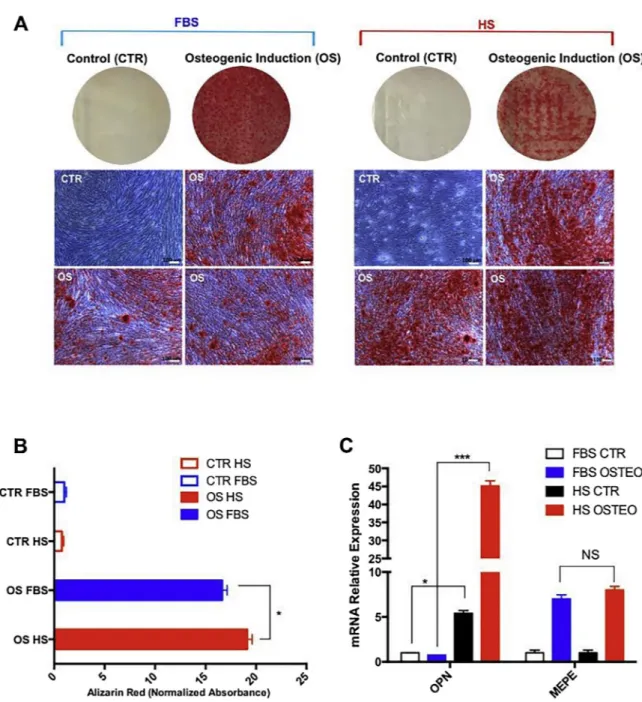ORIGINAL
ARTICLE/ARTICOLO
ORIGINALE
358
CONGRESSO
NAZIONALE
BOLOGNA
2017
—
VINCITORE
PREMIO
RICCARDO
GARBEROGLIO
Human
Periapical
Cysts-Mesenchymal
Stem
Cells
Cultured
with
Allogenic
Human
Serum
are
a
‘‘clinical-grade’’
construct
alternative
to
bovine
fetal
serum
and
indicated
in
the
regeneration
of
endo-periodontal
tissues
Le
human
periapical
cysts-mesenchymal
stem
cells
coltivate
con
siero
umano
allogenico
costituiscono
un
costrutto
‘‘clinical-grade’’
alternativo
al
siero
fetale
bovino
ed
indicato
nella
rigenerazione
dei
tessuti
endo-parodontali
Marco
Tatullo
a,*
,
Massimo
Marrelli
a,
Francesca
Palmieri
a,
Carlo
Rengo
b,
Francesco
Paduano
a,
Gianrico
Spagnuolo
ba
TecnologicaResearchInstitute,StemCellUnit,Crotone,Italy
bDepartmentofNeurosciences, Reproductiveand OdontostomatologicalSciences,UniversityofNaples‘‘FedericoII’’,
Naples,Italy
Received17November2017;accepted20March2018 Availableonline6April2018
KEYWORDS
Regenerativemedicine;
Stemcells;
Osteogenesis;
Humanperiapical
cyst-MSCs;
Translationalresearch.
Abstract
Aim: Ourresearchinvestigatedtheuseofhumanserum(HS)asasafeandclinical-gradeculture medium,usinganewcell-model:hPCy-MSCs.Thisarticleisaimedtoconcretelyapplicatethe concept of ‘‘waste-based regenerative dentistry’’to translateitin future endo-periodontal applications.
Methodology: HPCy-MSCswereculturedin2differentmediums,bothcontaininga-MEM:the1st with10%FBS(Controlgroup),andthe2ndwith10%humanserum(Testgroup).
PeerreviewunderresponsibilityofSocieta` ItalianadiEndodonzia.
* Correspondingauthorat:TecnologicaResearchInstitute,StreetEnricoFermi,88900Crotone,Italy.Tel./fax:+390962930414. E-mail:[email protected](M.Tatullo).
Availableonlineatwww.sciencedirect.com
ScienceDirect
jo ur na l h o m ep a ge : w w w.e ls e v i er.c o m / lo c at e /gi e
https://doi.org/10.1016/j.gien.2018.03.003
1121-4171/ß2018Societa` ItalianadiEndodonzia.ProductionandhostingbyElsevierB.V.ThisisanopenaccessarticleundertheCCBY-NC-ND license(http://creativecommons.org/licenses/by-nc-nd/4.0/).
Introduction
Thediscoveryofhumanperiapicalcysts-mesenchymalstem
cells(hPCy-MSCs)has,forthefirsttime,introduceddentistry
intheconceptof‘‘regenerativewastemedicine’’,the
regen-erative medicine obtainable from the reuse of biological
wastetoexploitittheclinicalpotential.HPCy-MSCsshowed
excellentability to differentiatebetweenosteogenic
phe-notypesandsurprisinglytowardthenervoustissue.1—3
Stem cell regeneration is, however, limited in clinical
practicefortheuseoffetalbovine serum(FBS),usedas a
nutritional supplementinculturemedia. Infact, its
xeno-genicorigindoesnotmakeFBSsecure inpatients
applica-tions.DespiteseveralMSCs from different sources,4and a
number of scaffold5—12 have been already described and
investigatedintheliterature,themainlimitationtoclinical
applicationsseemstobethestandardizationofclinical-grade
procedures,toovercomeimmunologicalandbiological
con-cernings.
In the light of the studies in the literature,13—16 our
researchanalyzedforthefirsttimehumanserum(HS)asa
safeand‘‘clinical-grade’’alternativeinregenerative
med-icine,usinganewcellularmodel:hPCy-MSCs,opening
inno-vative scenarios on the concept of ‘‘waste regenerative
dentistry’’infutureendo-periodontalapplications.
Materials
and
methods
HPCy-MSCswereobtainedasdescribedinliterature1,3 and
culturedinamediumcontaininga-MEMwith10%FBS(Gibco)
intheControlgroup,andwith10%humanserum(HS,Sigma)
inthetestgroup.TheHSusedinthisstudy(ABplasma)isused
asbythesupplierprotocol.
PAROLE
CHIAVE
Medicinarigenerativa;
Cellulestaminali;
Osteogenesi;
Humanperiapical
cyst-MSCs;
Ricercatraslazionale.
Cellproliferation and stemness assays, geneexpression, immunophenotypic analysis and osteogenicdifferentiationwereperformedtoverifyourhypothesis.cDNAsampleswere ampli-fiedwithqPCR.
Experimentswereperformedintriplicateandanalysedwithstatisticalsoftware.
Results: ThehPCy-MSCscultivatedinamediumwithHSweremorphologicallysimilartothose cultivatedwithFBS,andshowedasignificantlyhigherproliferationrate.VonKossa’sstaining revealedthatosteoblastsfromhPCy-MSCsinHSimplementedwithosteogenicinductionfactors, showedabetterosteogenicactivity,alsoconfirmedbyasignificantupregulationofosteopotin (OPN)andmatrixextracellularphosphoglycoprotein(MEPE).
Conclusions: HPCy-MSCscultivatedinHSshowedphenotypicstabilityandaclearregenerative binding,thus,suggestingthesetwocomponentsasaclinically-gradeconstructforfuture endo-periodontaltherapies.
ß2018Societa` ItalianadiEndodonzia.ProductionandhostingbyElsevierB.V.Thisisanopen accessarticleundertheCCBY-NC-NDlicense(http://creativecommons.org/licenses/by-nc-nd/ 4.0/).
Riassunto
Obiettivi: Lanostraricercahaanalizzatol’utilizzodelsieroumano(HS)comemezzodicoltura sicuroe‘‘clinical-grade’’,perusoclinico,utilizzandounnuovomodellocellulare:lehPC-MSCs. Questoarticolohaloscopodiapplicareconcretamenteilconcettodi‘‘odontoiatriarigenerativa basatasuirifiutibiologici’’,alfineditradurloinfutureapplicazioniendo-periodontali. Materialiemetodi: LeHPCy-MSCssonostatecoltivatein2mezzidicolturadiversi,entrambi contenentia-MEM:ilprimocon10%diFBS(gruppodicontrollo)eilsecondoconil10%disiero umano(gruppoditest).
Sonostatieseguitisaggidiproliferazionecellulareedistaminalita`,espressionegenica,analisi immunofenotipicaedifferenziamentoosteogenicoperverificarelanostraipotesidipartenza. CampionidicDNAsonostatiamplificaticonqPCR.
Gliesperimentisonostatieseguitiintriplicatoeanalizzaticonsoftwarestatistici. Risultati: LehPC-MSCcoltivatein unterrenoconHSeranomorfologicamentesimiliaquelle coltivate con FBS e mostravano un tasso di proliferazione significativamente piu` alto. La colorazionediVonKossaharivelatochegliosteoblastidahPC-MSCcoltivateinHSimplementato confattoridiinduzioneosteogenicahannomostratounamiglioreattivita` osteogenica, confer-mataanchedaunasignificativaup-regolazionediosteopotina(OPN)efosfoglicoproteinadella matriceextracellulare(MEPE).
Conclusioni: Le HPCy-MSC coltivate in HS hanno mostrato stabilita` fenotipica e un chiaro atteggiamentorigenerativo, suggerendoquindiquestoprotocollocome unapproccio clinica-mentevalidoperlefutureterapieendo-periodontali.
ß2018Societa` ItalianadiEndodonzia.ProductionandhostingbyElsevierB.V.Cetarticleest publie´ enOpenAccesssouslicenceCCBY-NC-ND( http://creativecommons.org/licenses/by-nc-nd/4.0/)
Cellproliferationtests,stemcellassays,geneexpression,
immunophenotypic analysis and osteogenic differentiation
testswereperformedwithquantitativeanalysistoverifyour
hypothesis.CDNA samples wereamplifiedwith qPCRusing
sequencesofprimers.
Experimentswereperformedintriplicate,anddata
eval-uatedwithGraphPadPrismsoftware(statisticallysignificant
differenceswith:*P<0.05;**P<0.01;P<0.001;N.S.=not
significant).
Results
The hPCy-MSCscultivated ina mediumwithHS were
mor-phologically similarto those cultivated withFBS(Fig. 1A);
however,hPCy-MSCsshowedasignificantlyhigher
prolifera-tionrate,fromday6(Fig.1B).Underbothculturing
condi-tions, theamount of vitalhPCy-MSCs was about thesame
(>95%,Fig.1C).Theexpressionofthemainstemnessgenes
hasbeenverified(Fig.1D).
Figure1 Proliferation,vitality,and expressionofstemmolecularmarkersin hPCy-MSCsgrowninHSorFBS.(A)Characteristic morphologyofhPCy-MSCscultivatedin10%HSor10%FBS(days1—13).(B)CellgrowthassayofhPCy-MSCsculturedin10%HSor10%FBS. *P<0.05. (C)Cellviabilityof hPCy-MSCscultured in10%HS or10%FBS. (D)Expression of mRNAfor thegeneticindicationsof staminality:Klf4,OCT4,Sox-2,Nanog,c-mycandtheCD146pericitarymarkerinhPCy-MSCsculturedin10%HSor10%FBSanalyzedby qRT-PCR.*P<0.05,**P<0.01,***P<0.001,N.S.,notsignificant.FBS,fetalbovineserum;HS,humanserum.
FlowcytometryofphenotypicmarkersofhPCy-MSCs
cul-tivated in HS and FBS (Fig. 2A) did not show statistically
significantdifferences(Fig.2B).
Von Kossa’s staining revealed that hPCy-MSCs induced
towardstheosteogenicphenotypeinHS,showedagreater
differentiationthanthosecultivatedinFBS(Fig.3AandB).
Theseobservationswereconfirmedbyasignificant
upregula-tionofosteopotin(OPN)andmatrixextracellular
phospho-glycoprotein (MEPE)in hPCy-MSCs cultivated inosteogenic
andbasalmediacontainingHS(Fig.3C).
Discussion
Patients treated with FBS-grown cells are exposed to a
concreteriskofimmunogenicityandtheriskoftransmission
Figure2 ExpressionofsurfacestemmarkersinhPCy-MSCscultivatedinHSorFBS.(A)Expressionofsurfacestemmarkers:CD13, CD29,CD44,CD73,CD90,CD105,CD146andCD45inhPCy-MSCscultivatedin10%HScomparedwiththosegrownin10%FBS.Thecontrol oftheisotypeisindicatedbytheemptyhistogram,whereasthecoloringof theantibodiesisindicatedbyasolidhistogram.(B) PercentagedataofsurfacestemmarkersinhPCy-MSCscultivatedin10%HScomparedwiththosegrownin10%FBS.(C)Geometricmean fluorescenceintensityofsurfacestemmarkersinhPCy-MSCscultivatedin10%HScomparedwiththosegrownin10%FBS.FBS,fetal bovineserum;HS,humanserum.
ofprion,bacterialorviralpathologies,makingFBSdangerous
foradvancedcelltherapy.13
For more than 30 years thescientific community has
requested the use of alternative supplements to FBS14
andin2011theEuropeanCommission,withthetechnical
note EMA/410/01, suggested that animal medicines be
avoided.
Recently,someauthorshavestudiedHSasanalternative
toFBSon stemcellmodelsofdentaloriginthatare
alter-native to our15,16; however, the plasticity of hPCy-MSCs
makes them ideal for regeneration to bone-like and
neu-ron-liketissues.
Conclusions
HPCy-MSCscultivated inHSshowedexcellent skillstowards
boneregeneration,alsoavoidingtherisksderivedfromtheuse
ofFBS,thus,suggestingthesetwocomponentsasa
clinically-gradeconstructforfutureendo-periodontaltherapies.
Clinical
relevance
Human periapical cysts-mesenchymal stem cells cultured
with allogenic humanserum are clinically usable, without
Figure3 OsteogenicdifferentiationpotentialofhPCy-MSCscultivatedinHSorFBS.(A)OsteogenicdifferentiationofhPCy-MSCs, growninHS,andcomparedwiththosegrowninFBS,coloredwithredAlizarin.(B)Quantificationbyredbloodalizarinetestforthe productionofmineralized matrixinhPCy-MSCscultivatedin HScomparedwiththosegrownin FBS.*P<0.05.(C)Expressionof osteogenic markers mRNA: OSP and MEPE in hPCy-MSCs cultivated in HS compared tothose cultured in FBS after 21 days of differentiation (OS). FBS, fetal bovine serum; HS, human serum; CTR, control; OS, osteogenic differentiation. *P<0.05, ***P<0.001,N.S.,notsignificant.
tousealternativexenogeneicserum.This‘‘clinical-grade’’
procedure,together withthegreat plasticityofhPCy-MSCs
andtherecentexperimentalresultsreportingtheirabilityto
differentiatetowardsbothbone-like,tooth-likeand
neuron-liketissues,makestheconstructmadefromsuchanewMSCs
and the ‘‘safe’’culture medium an implantable biological
devicegreatlyindicatedintheregenerationof
endo-period-ontaltissues.
Conflict
of
interest
Wedisclosenoconflictofinterest.
References
1.Marrelli M, Paduano F, Tatullo M.Cells isolated from human periapicalcystsexpressmesenchymalstemcell-likeproperties. IntJBiolSci2013;9:1070—8.
2.TatulloM,FalisiG,AmanteaM,RastelliC,PaduanoF,MarrelliM. Dentalpulpstemcellsandhumanperiapicalcystmesenchymal stemcellsinbonetissueregeneration:comparisonofbasaland osteogenicdifferentiatedgeneexpressionofanewlydiscovered mesenchymalstemcelllineage.JBiolRegul HomeostAgents 2015;29:713—8.
3.Marrelli M, Paduano F, Tatullo M. Human periapical cyst-mesenchymalstemcellsdifferentiateintoneuronalcells.JDent Res2015;94:843—52.
4.PaduanoF,MarrelliM,AmanteaM,RengoC,RengoS,GoldbergM, et al. Adipose tissue as a strategic source of mesenchymal stemcellsinboneregeneration:atopicalreviewonthemost promising craniomaxillofacial applications. Int J Mol Sci 2017;18.
5.PaduanoF,MarrelliM,AlomN,AmerM,WhiteLJ,ShakesheffKM, etal.Decellularizedboneextracellularmatrixandhumandental pulpstemcellsasaconstructforboneregeneration.JBiomater SciPolymEd2017;28:730—48.
6.PaduanoF,MarrelliM,PalmieriF,TatulloM.CD146expression influences periapicalcyst mesenchymalstem cell properties. StemCellRev2016;12:592—603.
7.Paduano F, Marrelli M, White LJ, Shakesheff KM, Tatullo M. Odontogenicdifferentiationofhumandentalpulpstemcellson hydrogelscaffoldsderivedfromdecellularizedboneextracellular matrixandcollagentypeI.PLOSONE2016;11:e0148225.
8.MarrelliM,FalisiG,ApicellaA,ApicellaD,AmanteaM,CieloA, etal.Behaviourofdentalpulpstemcellsondifferenttypesof innovative mesoporous and nanoporous siliconscaffolds with differentfunctionalizationsofthesurfaces.JBiolRegul Home-ostAgents2015;29:991—7.
9.PerniconiB,ColettiD,AulinoP,CostaA,AprileP,SantacroceL, etal.Muscleacellularscaffoldasabiomaterial:effectsonC2C12 celldifferentiationandinteractionwiththemurinehost envir-onment.FrontPhysiol2014;5:354.
10.AulinoP,CostaA,ChiaravallotiE,PerniconiB,AdamoS,Coletti D,etal.Muscleextracellularmatrixscaffoldisamultipotent environment.IntJMedSci2015;12:336—40.
11.MarrelliM,PujiaA,PalmieriF,GattoR,FalisiG,GargariM,etal. Innovative approach for the in vitro research on biomedical scaffoldsdesignedandcustomized withCAD-CAMtechnology. IntJImmunopatholPharmacol2016;29:778—83.
12.MarrelliM,MalettaC,InchingoloF,AlfanoM,TatulloM. Three-pointbendingtestsofzirconiacore/veneerceramicsfordental restorations.IntJDent2013;2013:831976.
13.Aldahmash A, Haack-Sørensen M, Al-Nbaheen M, Harkness L, AbdallahBM,KassemM.Humanserumisasefficientasfetalbovine serum insupporting proliferationand differentiation of human multipotentstromal(mesenchymal)stemcellsinvitroandinvivo. StemCellRev2011;7:860—8.
14.Tekkatte C, Gunasingh GP, CherianKM,Sankaranarayanan K. ‘‘Humanized’’stemcellculturetechniques:theanimalserum controversy.StemCellsInt2011;2011:504723.
15.JaymeDW,EpsteinDA,ConradDR.Fetalbovineserum alter-natives.Nature1988;334:547—8.
16.Pisciotta A, Riccio M, Carnevale G, Beretti F, Gibellini L, MaraldiT,etal.Humanserumpromotesosteogenic differentia-tionofhumandentalpulpstemcellsinvitroandinvivo.PLoS ONE2012;7:e50542.


